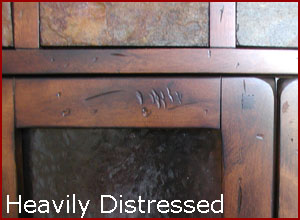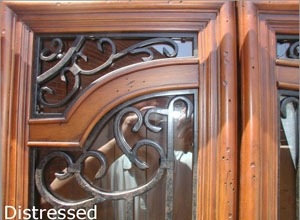| Experience EASY online shopping with Home Furniture Mart |
| Best Value | Fast Delivery | Free Shipping |
Furniture Finishes
Distressed Finish
Distressing is meant to give an item a vintage or one-of-a-kind look, which is usually supposed to be old and rustic. There are many different ways that you can change the appearance of the furniture that you have, or of any other object. One of the ways is to do distressed wood finishing. When you do distressed wood finishing, you are really giving yourself a chance to have an amazing piece of furniture come to life before your very eyes. Distressing is a way of making something that is made out of wood, or out of almost any other material, look like it is older and more aged. It is usually considered to be a decorative art, because you are changing the way that the item looks, in order to make it more pleasing to your own eye. Also, distressed wood finishing is looked at as a finishing technique, because it is something that you do that leads to the final design of the piece of furniture. Even though it is called distressed wood finishing, it is really the opposite of finishing, because you are taking a final product that looks brand new, and doing things to it to make it look older and more distressed.
When you distress a piece of wood, you are deliberately making it look older. This might mean that you destroy or manipulate the current finishing on the object, in order to make it look less than perfect. You can do this with sandpaper, and also with something like a paint stripper. Sometimes, you might take off some of the layers of paint, but not all of it, so there might still be layers of paint that are visible over a wood grain that is underneath. After you have distressed the item, you will have a finished product.
In many ways, distressing has become an art form, and a way to decorate furniture and other items in a popular and stylish way.
Antiquing is another type of distressing for wood furniture. When someone does antiquing, they are not only trying to make a piece look older, but they are also trying to make the piece look like it is an antique. There are several different ways that this can be done. First of all, the finish is often distressed, meaning that sanders are used to take off some of the paint and to make the entire thing look like it is older. Secondly, the artisan often applies historically accurate paint colors, and puts on an antique-like faux finish. Sometimes, crackle varnishes are used. Sometimes, in order to complete the antiquing method of distressing, the artisan applies accent details that were only found in that particular period of time, like knobs on dresser drawers, or other details that would make the piece appear to be an antique. Sometimes, glazes are used. With glazing, after distressing, the colors blend into the crevices, and give it an older or antique appearance. Many times, if a person wants to continue the distressing in order to achieve the antique look, it is a process that is going to take a long time, and one that might end up being a lot of work. Another aspect of distressing is putting in things that are made to look natural. For instance, distressing often includes putting in fake woodworm holes. These are holes in the piece that look like they were made by woodworms. There are many ways to actually distress an item, whether the artisan is doing antiquing or just distressing. First of all, they might sand the finish off of the actual wood item. They might do this by hand or with an electric sander. Also, they might purposefully dent and scrape the object, in order to make it look like it has a lengthy history and has been moved around a lot. Sometimes, wood is hammered in order to make it softer, and sometimes it is hammered to give it a dimpled appearance. It can also be bleached, stained, pickled, or repainted with paints and varnishes that crackle. These will then crack after drying, making it appear that the paint or varnish has cracked due to age. Sometimes, antique paints and varnishes are used, which also add to the appearance of an older, wooden item. Another technique includes watering down regular paint, so that it appears to be faded and thinner than it would new. This allows other layers of paint, or the wood itself, to show through the paint layer. Another distressing technique calls for the pain or varnish to be layered on using sponges, which will create an uneven pattern. When an area is painted, the corners and edges are often painted lighter, or sanded down, so that the item appears to be worn.
The goal of all of these different methods of distressing is the same - for the object to appear as if it is older than it is, and for the object to appear as if it has been worn down and is not in as great of shape as a newer item. Distressed wood furniture is often preferred because it appears to have more character and to look like it has a story and history behind it. Therefore, distressed wood furniture is actually quite popular - even if it is something that a person makes for themselves. One can take a regular piece of furniture and distress it so that it looks even better.
Examples:










